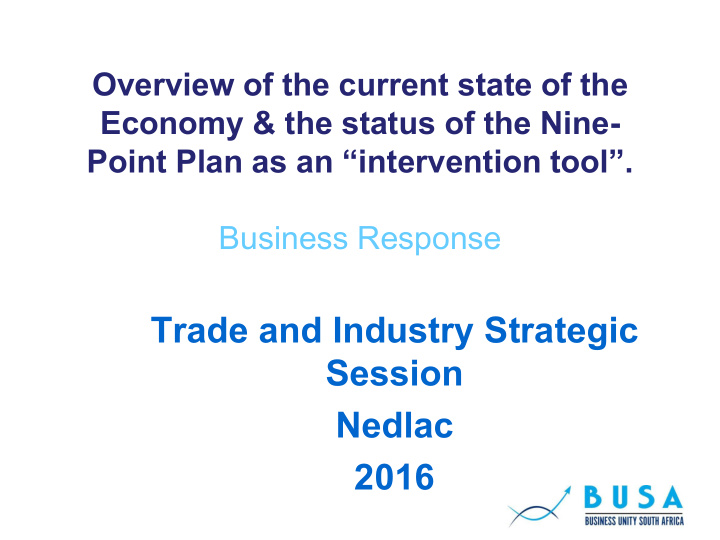



Overview of the current state of the Economy & the status of the Nine- Point Plan as an “intervention tool”. Business Response Trade and Industry Strategic Session Nedlac 2016
Overview of State of the Economy • According to the latest forecast by the South African Reserve Bank, the economy will generate no growth this year. • According to the latest data from Stats SA, the country’s economy grew at 3.3% quarter on quarter in the second quarter of 2016 after contracting in the first quarter of this year by - 1.2% quarter on quarter and -0.2% year on year. • SA’s current growth rates are significantly below those of advanced economies, developing economies and the world average. The economy is therefore growing below potential.
Overview of State of the Economy (2) • Average growth rates in recent years have declined from 4.3% between 2000 – 2007 to 2.1% between 2010 – 2016. • Uncertainties in the global economy impact on SA’s growth rates. These include debt overhang in advanced economies, declining productivity and aging populations, stalled globalisation and a Chinese economy in transition. • SA, as small open economy, vulnerable to potential global shocks.
Overview of State of the Economy (3) • Subdued growth rates have resulted in a steadily increasing government debt to GDP ratio of 50.1%, reducing fiscal space and increasing the likelihood of a sovereign ratings downgrade at the end of 2016. • A downgrade could result in the short term in ↑ interest rates and a weakened ZAR. Over the long term, a reversal of capital flows and recession could result. • There would be further knock-on effects on both fiscal and monetary policy.
Overview of State of the Economy (4) • Structural problems such as high unemployment and income inequality remain persistent. Sustainability of social programmes in low- growth context may be affected. • On the positive side, recent data on the balance of trade have shown improvements: In Q2 2016 the country's trade account switched to a R33 billion surplus on a seasonally adjusted basis from a R48 billion deficit in the first quarter.
Overview of State of the Economy (5) • Other good news is SA’s current account deficit narrowed to 3.1% of (GDP) in the second quarter of this year after a 5.3% deficit in Q1 (SARB). • According to SARB, growth in real disposable income edged higher from an annualised rate of 0.4% in the first quarter of 2016 to 0.7% in the second quarter. • Of concern however is that households continued to incur debt in the second quarter of 2016. The ratio of household debt to disposable income now stands at 75.1%. • Recent rand weakness may also lead to a 25 basis point hike in interest rates.
Nine-Point Plan • First announced in 2015 SONA and consists of: 1. Resolving the Energy Challenge; 2. Revitalising agriculture and the agro- processing value chain 3. Advancing beneficiation or adding value to the mineral wealth 4. More effective implementation of a higher impact Industrial Action Policy Action Plan (IPAP)
Nine-Point Plan (2) 5. Encouraging private-sector investment 6. Moderating workplace conflict 7. Unlocking the potential of SMMEs, cooperatives, townships and rural enterprises 8. State reform and boosting the role of state-owned companies, information and communications technology infrastructure or broadband roll-out, water, sanitation and transport infrastructure 9. Operation Phakisa, which is aimed at growing the ocean economy and other sectors
Nine-Point Plan • Business has been active in various workstreams to ensure the success of the intervention, with linkages established to existing engagements through Nedlac, bilateral forums, Presidential Business Working Groups, the CEO Initiative, etc. • Business views the Plan as holding significant potential to unlock the value of the sectors covered. • Of importance for the overall performance of the economy however is progress in energy policy – particularly an updated IEP and IRP. Only in this way will SA be positioned to take advantage of any uptick in economic growth.
Nine-Point Plan (Agriculture Case Study) • Chapter 6 of the NDP as basis • 1,0 million jobs created by 2030 • Stable and predictable Land Reform critical • Water availability and reform critical • Skills (capabilities) critical • Agro-food Workstream established through CEO Process: Interventions being finalized – expanded trade and agro-processing major drivers • Drought very significant factor – NAMC Section 7 Committee analysing impact of drought and interventions • Policy uncertainty and other factors impacting on investment environment.
Conclusion • The economy is experiencing significant headwinds with resulting reductions in monetary and fiscal space. • Structural impediments to growth remain high. • However, unlocking of value in identified sectors through an appropriate policy environment and regulatory regime, together with ongoing dialogue between business, government and labour, can generate inclusive economic growth.
Recommend
More recommend